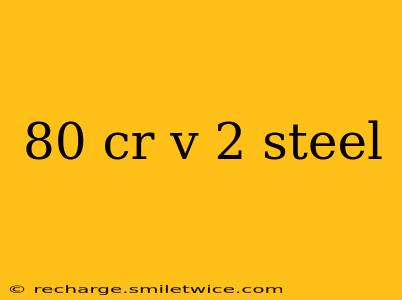80CrV2 steel, also known as 80CrV2, is a high-carbon, chromium-vanadium alloy steel renowned for its exceptional strength, toughness, and wear resistance. This makes it a highly versatile material used in a wide range of applications, from demanding automotive components to precision tools. Understanding its properties and heat treatment is crucial for maximizing its performance.
What are the key properties of 80CrV2 steel?
80CrV2 steel boasts a compelling combination of properties that set it apart. Its high carbon content contributes significantly to its hardness and wear resistance. The chromium addition enhances corrosion resistance and increases hardenability, allowing for deeper and more uniform hardening during heat treatment. Vanadium further refines the grain structure, improving toughness and contributing to the overall strength of the steel. This synergistic effect of the alloying elements results in a material capable of withstanding significant stress and wear.
Key properties include:
- High Hardness: Achievable through proper heat treatment, resulting in excellent wear resistance.
- High Strength: Offers superior tensile strength, making it suitable for high-stress applications.
- Good Toughness: Maintains its impact resistance even at high hardness levels.
- Excellent Wear Resistance: Resists abrasion and wear, extending the lifespan of components.
- Good Hardenability: Allows for deep hardening, crucial for larger components.
- Moderate Corrosion Resistance: Offers better corrosion resistance compared to plain carbon steels.
What are the common applications of 80CrV2 steel?
The exceptional properties of 80CrV2 steel translate into a diverse range of applications across various industries:
- Automotive: Used in gears, axles, crankshafts, and other high-stress components demanding both strength and durability.
- Tooling: A popular choice for punches, dies, cutting tools, and other tooling applications where wear resistance is paramount.
- Machinery: Employed in components subjected to high loads and impact forces.
- Agricultural Machinery: Used in parts of equipment like harvesters and tractors that are subject to considerable wear and tear.
- Hand Tools: Found in high-quality wrenches, screwdrivers, and other hand tools requiring durability and strength.
How is 80CrV2 steel heat treated?
Heat treatment is crucial for realizing the full potential of 80CrV2 steel. The process typically involves:
- Austenitizing: Heating the steel to a specific temperature (typically around 820-880°C) to transform the microstructure into austenite.
- Quenching: Rapidly cooling the austenite, usually in oil or water, to transform it into martensite, a hard and brittle structure.
- Tempering: Heating the quenched steel to a lower temperature (typically between 150-600°C) to reduce brittleness and increase toughness. The tempering temperature determines the final balance between hardness and toughness.
What are the advantages of using 80CrV2 steel?
The advantages of utilizing 80CrV2 steel are numerous:
- High Performance: Its exceptional strength, toughness, and wear resistance lead to superior performance in demanding applications.
- Long Lifespan: The durability of 80CrV2 steel extends the lifespan of components and tools.
- Cost-Effective: While a higher-grade steel, its performance often justifies the slightly increased cost compared to lower-grade materials due to its longevity and reduced maintenance.
What are some alternatives to 80CrV2 steel?
Depending on the specific application requirements, alternative steels might include:
- 4140 Steel: Offers good strength and toughness but may not have the same level of wear resistance.
- 5140 Steel: Provides similar properties to 4140 but with improved hardenability.
- 4130 Steel: A lower-alloy steel offering good strength and toughness.
The choice of the best alternative will depend on the specific design requirements and cost considerations.
How does 80CrV2 steel compare to other chromium-vanadium steels?
80CrV2 differs from other chromium-vanadium steels primarily in its carbon content. Higher carbon content contributes to greater hardness and wear resistance but can also make the steel more brittle if not properly heat-treated. Other chromium-vanadium steels might prioritize other properties like ductility or toughness depending on their specific alloying composition.
This detailed analysis of 80CrV2 steel provides a comprehensive understanding of its properties, applications, and heat treatment, empowering engineers and manufacturers to make informed decisions when selecting materials for demanding applications. Remember that the information provided here is for general knowledge and should not be considered a substitute for professional engineering advice.
